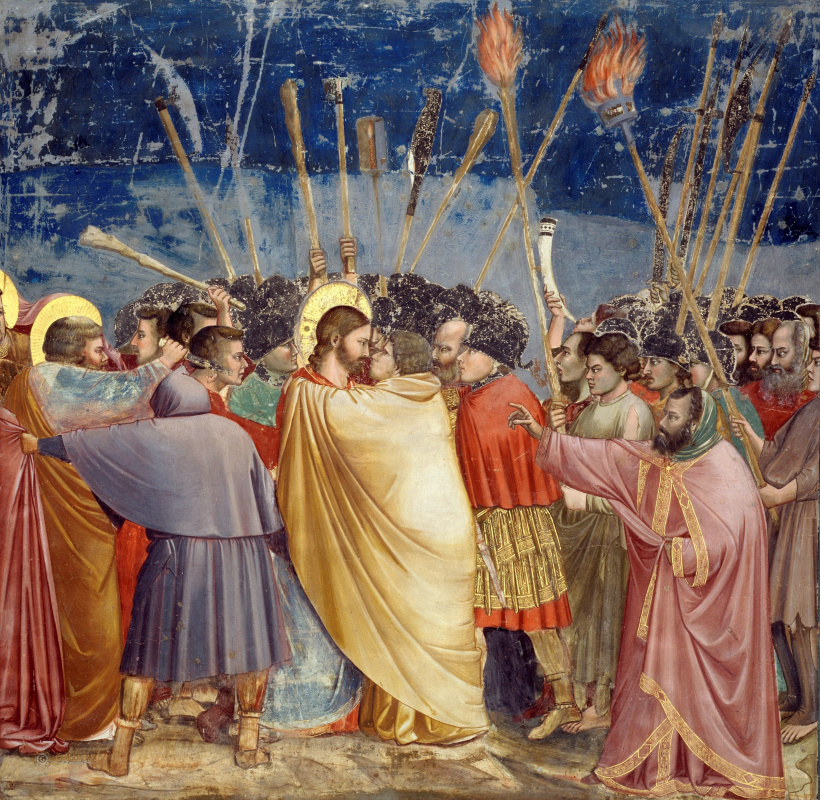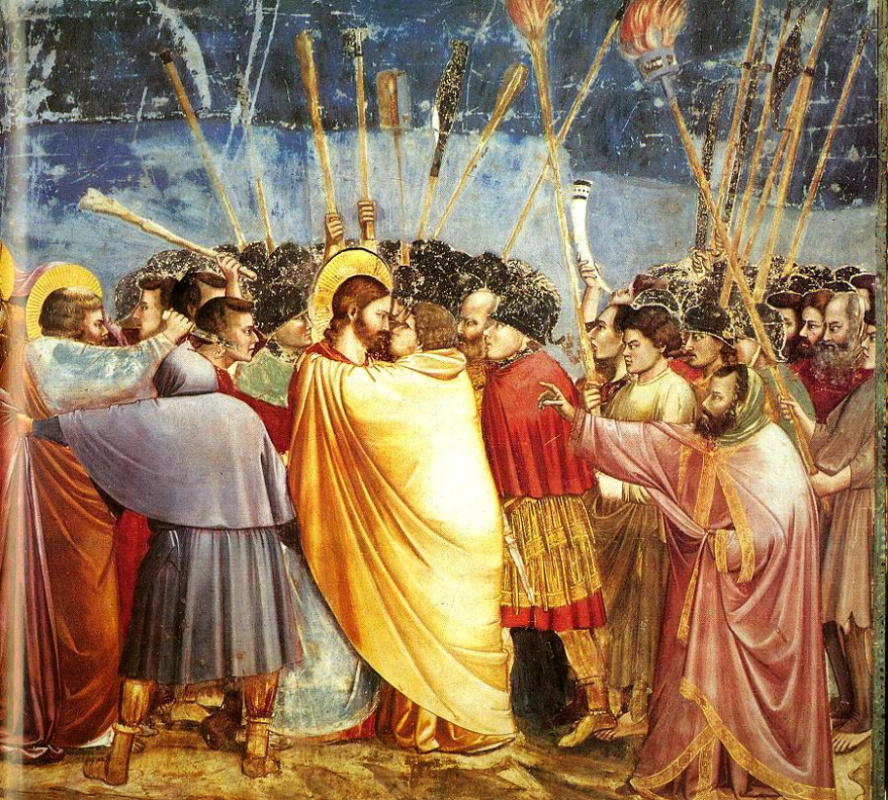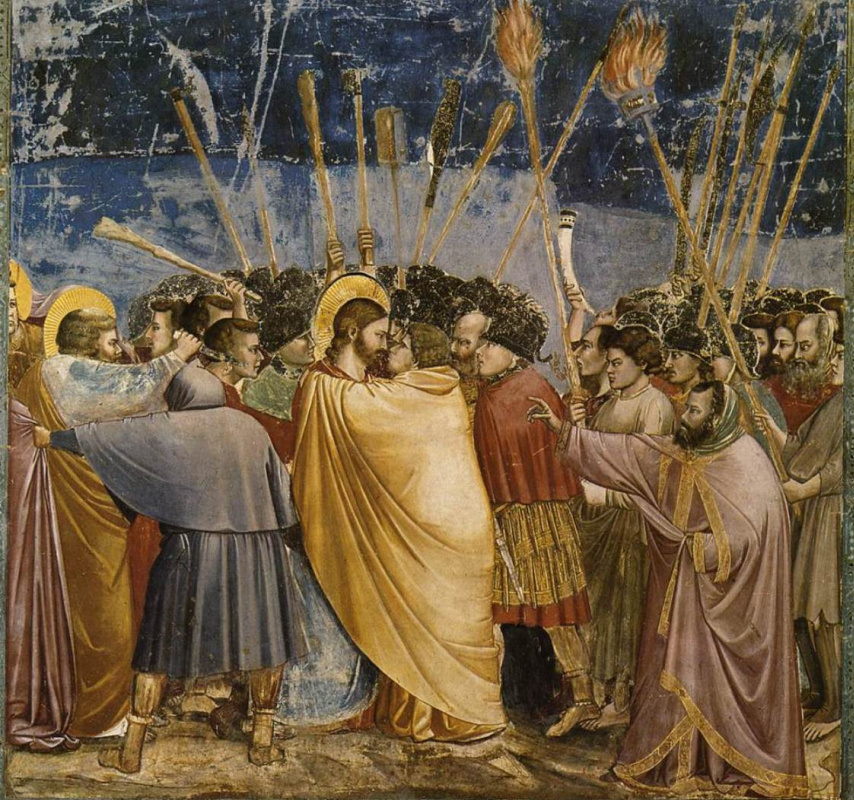log in
Enter site
Login to use Arthive functionality to the maximum
Taking Christ in custody (The Kiss of Judah). Scenes from the life of Christ
Джотто ди Бондоне • Painting, 1306, 185×200 cm
Description of the artwork «Taking Christ in custody (The Kiss of Judah). Scenes from the life of Christ»
"The Taking of Christ in Custody, or the Kiss of Judas" - one of the most expressive and heartfelt frescoes of Giotto in the Scrovegni Chapel, a small private chapel in the city of Padua in northern Italy, which provided the unfading fame of Giotto for seven centuries ahead.
"The kiss of Judas" shakes the viewer unprecedented (and almost inconceivable for the beginning of the trencent, when the fresco was created) by emotional heat. We become witnesses of a restless pandemonium, we see long torches, swords and spears trembling in unfaithful hands against the background of a dark blue night sky and we feel how the air is electrified on the threshold of the events that are under way. The guards are ready to take into custody the one who will be kissed by Judas. Truth here encounters betrayal, absolute good with evil. The faces of Christ and Judas personify this opposition, this striking contrast.
This is how the art critic describes him Paola Volkova in the video cycle "Bridge over the Abyss":
"... The noble, beautiful face of Christ: golden thick hair, a light brow, a calm gaze, a column of neck, a serious, focused face. So Christ - as a hero, as an amazingly beautiful person - will later, 100 years later, depict the Italian Renaissance. This is very important: not exhausted, tormented face, not bleeding on the cross body, not tormented flesh, but a beautiful man full of strength. And to him brings his face some kind of a black boar, a black pig! If the forehead of Christ is convex, then it is concave, like a Neanderthal man; Little eyes under the pendulous frontal bones peer into his eyes. "
Christ is perfect and beautiful, Judah is ugly and fat, this clothing can not hide. The cloak of Judas on this fresco is considered one of the great picturesque achievements of Giotto. Firstly, no one before him portrayed the drapery of clothing so believably describing the contours of the body and conveying the impetuosity of the movement. Secondly, Giotto's most interesting composition solution was to write Judas' cloak so that he almost completely covered Christ, as if absorbing it.
Much of what we see in Jott's "Kiss of Judas" appears in the history of painting for the first time. For the first time the artist depicts what will later be called a "duel of views." For the first time the finished icon-painting canon, which came from Byzantine painting, replaces the realistic scene full of drama and excitement. For the first time the crowd is so vividly heterogeneous. The apostle took out a bread knife and cut off the guard's ear in an affect. The priest in the foreground points with his finger: "Take it!" Someone, deployed with his back, pulls someone nearby for clothes. The guard next to Judas in a high black helmet in a crush comes on foot standing next to him. And someone (probably an angel) in the background already blows a horn, anticipating Christ's Resurrection. Bearded and beardless, dark and fair-haired, with individually different profiles, shod and barefoot, dressed in different colors and shapes - they all show how interested Italian art becomes with the advent of Giotto.
The biblical frescoes of the Italian Giotto di Bondone were so different from the Byzantine (Greek) icon-painting canon that the artist and art theorist of the 14th-15th centuries. Chennino Chennini wittily remarked: "Giotto translated the Bible from Greek into Latin".
Author: Anna Yesterday
"The kiss of Judas" shakes the viewer unprecedented (and almost inconceivable for the beginning of the trencent, when the fresco was created) by emotional heat. We become witnesses of a restless pandemonium, we see long torches, swords and spears trembling in unfaithful hands against the background of a dark blue night sky and we feel how the air is electrified on the threshold of the events that are under way. The guards are ready to take into custody the one who will be kissed by Judas. Truth here encounters betrayal, absolute good with evil. The faces of Christ and Judas personify this opposition, this striking contrast.
This is how the art critic describes him Paola Volkova in the video cycle "Bridge over the Abyss":
"... The noble, beautiful face of Christ: golden thick hair, a light brow, a calm gaze, a column of neck, a serious, focused face. So Christ - as a hero, as an amazingly beautiful person - will later, 100 years later, depict the Italian Renaissance. This is very important: not exhausted, tormented face, not bleeding on the cross body, not tormented flesh, but a beautiful man full of strength. And to him brings his face some kind of a black boar, a black pig! If the forehead of Christ is convex, then it is concave, like a Neanderthal man; Little eyes under the pendulous frontal bones peer into his eyes. "
Christ is perfect and beautiful, Judah is ugly and fat, this clothing can not hide. The cloak of Judas on this fresco is considered one of the great picturesque achievements of Giotto. Firstly, no one before him portrayed the drapery of clothing so believably describing the contours of the body and conveying the impetuosity of the movement. Secondly, Giotto's most interesting composition solution was to write Judas' cloak so that he almost completely covered Christ, as if absorbing it.
Much of what we see in Jott's "Kiss of Judas" appears in the history of painting for the first time. For the first time the artist depicts what will later be called a "duel of views." For the first time the finished icon-painting canon, which came from Byzantine painting, replaces the realistic scene full of drama and excitement. For the first time the crowd is so vividly heterogeneous. The apostle took out a bread knife and cut off the guard's ear in an affect. The priest in the foreground points with his finger: "Take it!" Someone, deployed with his back, pulls someone nearby for clothes. The guard next to Judas in a high black helmet in a crush comes on foot standing next to him. And someone (probably an angel) in the background already blows a horn, anticipating Christ's Resurrection. Bearded and beardless, dark and fair-haired, with individually different profiles, shod and barefoot, dressed in different colors and shapes - they all show how interested Italian art becomes with the advent of Giotto.
The biblical frescoes of the Italian Giotto di Bondone were so different from the Byzantine (Greek) icon-painting canon that the artist and art theorist of the 14th-15th centuries. Chennino Chennini wittily remarked: "Giotto translated the Bible from Greek into Latin".
Author: Anna Yesterday




